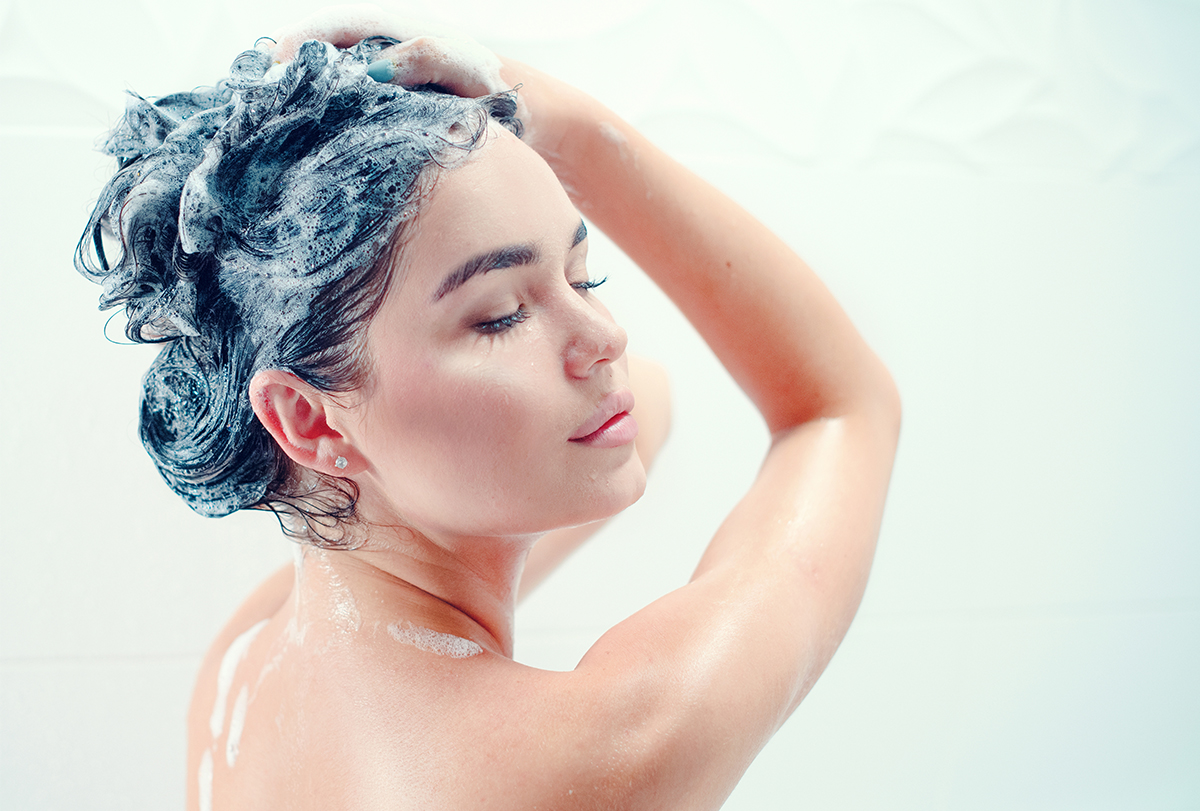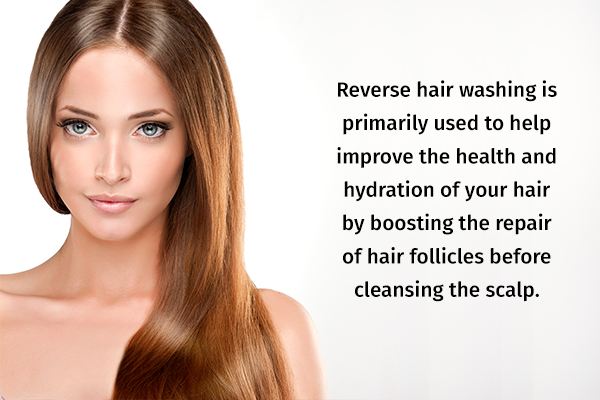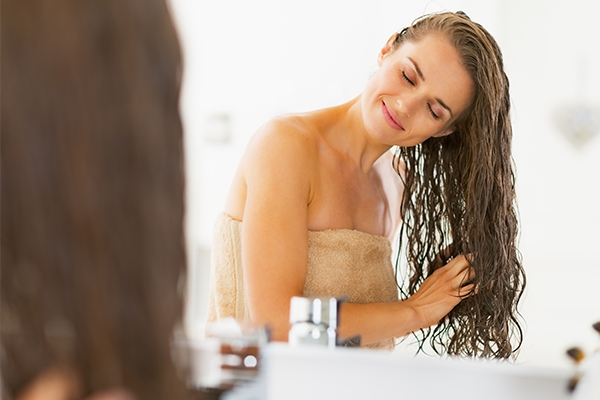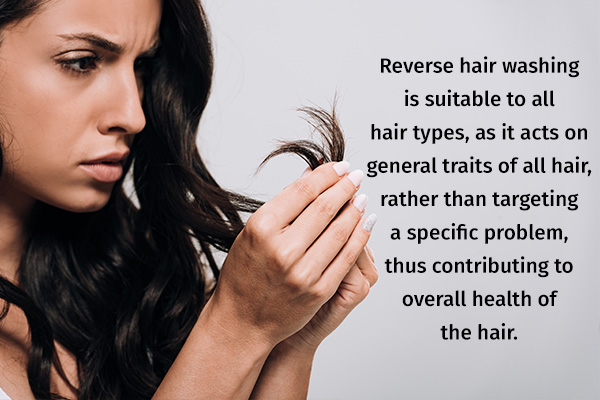In this article:
Everyone’s hair care routine is different, varying according to their hair type, texture, and needs. One common thing among hair care routines is hair washing, which includes shampooing the scalp and hair, followed by conditioning the hair shaft.

While this method is effective in cleaning your hair and largely popular, it may leave your hair lifeless after a few hours or a day, especially if you have oily or thin hair.
Making a simple change to your shampooing ritual can improve your hair care routine, making your hair look fresh for longer. Simply condition your hair first, and then shampoo it – a technique known as reverse hair washing.
Reverse hair washing has recently gained popularity for improving the appearance of low-volume, dry, damaged, or frizzy hair types.
What is Reverse Hair Washing?
Reverse hair washing is a recently popular technique that involves conditioning the hair first and then using a mild shampoo to cleanse your hair.
This method of hair washing is gentler on the hair and often improves hair health by improving hair growth and softness. It also adds shine, bounce, and volume to the hair.
How Reverse Washing Works
Conditioners are an important part of any hair care routine as they nourish and hydrate the hair, locking in the moisture. More importantly, conditioners coat the hair shaft and protect it from damaging chemicals and pollutants.
When you condition before shampooing, your hair is protected from the harsh chemicals present in the shampoo. The shampoo cannot penetrate the hair coated by a conditioner, thus helping preserve the natural oils and moisture in your hair.
Moreover, by washing off the conditioner with the shampoo, your hair stays light for longer, as the leftover conditioner can often weigh your hair down and give it a greasy appearance.
By performing reverse hair washing, you give a milder and more nourishing cleanse to your hair, leaving your hair bouncier and softer. It prevents product buildup in the hair, which is beneficial for hair types prone to clogging of pores. This technique also averts hair damage and split ends.
You can also employ the technique of reverse hair washing with hair masks to prevent over nourishment of the hair.
Pros of Reverse Hair Washing

It is primarily used to help improve the health and hydration of hair by boosting the repair of hair follicles before cleansing the scalp.
Reverse hair washing can have the following benefits as well:
- Helps improve the texture of dull, flat hair
- Gives better nourishment without making the hair appear flat
- Helps treat hair fall problems
- Makes the hair more bouncy, shiny, and voluminous (1)
- Lowers the amount of shampoo required
- Prevents hair frizziness (1)
- Helps avoid hair oiliness and greasiness
- Prevents scalp buildup and clogging of pores
Cons of Reverse Hair Washing
Generally speaking, there are no such side effects of reverse hair washing. The only thing is that this technique may not help much with thick and coarse hair. However, there is no harm in trying it.
How to Do Reverse Hair Washing

Reverse hair washing can be done by following these steps:
- Wet your hair thoroughly.
- Apply the conditioner to the whole length of your hair thoroughly and leave it for 3–5 minutes. Make sure to avoid applying the conditioner or hair mask to the scalp and roots to prevent greasiness.
- Rinse your hair gently with plain water. Avoid scrubbing your hair as you want the conditioner to stay as a coat on your hair for protection.
- If you have dry, rough ends, apply a good amount of conditioner to the hair tips and splash some water over them instead of rinsing completely.
- Take a small amount of shampoo and lather it up in your hair.
- Rinse your hair, and repeat shampooing if it is part of your routine.
- Apply a conditioner before the final rinse, or use a leave-in conditioner while your hair is still wet.
- Apply a serum to towel-dried hair and allow it to air-dry.
Reverse hair washing helps in cleansing the hair gently and leaving it softer, but do not switch to reverse hair washing entirely as it doesn’t cleanse the hair as thoroughly as normal shampooing.
It is best to use reverse hair washing once a week, for about a month, to notice changes in your hair.
Who Should Do Reverse Hair Washing?

Reverse hair washing, when performed correctly and in moderation, can benefit all hair types, regardless of the texture or length.
- It is generally recommended for people with lifeless, dull, or thin hair, as it prevents the conditioner from weighing down the hair.
- Reverse hair washing is also useful for those with an oily scalp, as conditioners can often contribute to the problem.
- People who try to avoid the use of conditioners but suffer from dry or frizzy ends can try reverse hair washing to improve their hair problems without resulting in oiliness.
- People with thick or dry hair can use reverse hair washing to improve their hair texture.
Reverse hair washing is suitable for all hair types as it acts on the general traits of all hair, rather than on a specific problem, thus contributing to overall hair health.
Conditioners for Reverse Hair Washing
You can use your regular hair conditioner for reverse hair washing and achieve significant results. You can also try switching conditioners every once in a while and use products that are more suited to your current hair problems.
While store-bought conditioners are widely available, you can also try natural oils or make herbal hair masks at home.
1. Store-bought conditioners

A wide range of conditioners are available, varying in their composition according to the hair problems they address.
Store-bought conditioners are the most common type of conditioner used for reverse hair washing, as most people already have them as a part of their normal hair washing routine.
A store-bought conditioner allows you to incorporate reverse hair washing without the need to buy new products or to increase your hair care budget. This also allows you to perform a trial run of the technique without having to spend extra.
However, store-bought conditioners are only best for those who have already healthy hair. People with hair problems such as dryness and split ends may benefit more from other options such as homemade masks.
Moreover, store-bought conditioners are laden with chemicals such as sulfates, parabens, propylene glycol, and other constituents that increase the shelf life of the product. They can also contain sodium and salts as thickening agents, which can irritate the scalp and hair.
Hence, when choosing commercially available conditioners, select products with as few chemicals as possible. In addition, look for conditioners that contain natural ingredients such as jojoba oil, argan oil, coconut oil, and shea butter.
2. Natural oils as conditioners
It is often recommended to apply natural oils to condition your hair before washing. (2) Oiling your hair moisturizes and nourishes the hair, while also helping you relax.
Consider the following methods when using natural oils as conditioners:
a. Condition using oils
You can use natural oils as a normal conditioner. Simply dampen your hair in the shower and apply the oil throughout the length of your hair. Follow by shampooing the hair.
b. Use oils as a mask
This involves applying the oil on dry, combed hair and leaving it on for half an hour before shampooing. You may require a teaspoon to a few tablespoons of the oil, depending on the type and length of your hair. You can try the following oils according to your hair type:
- For oily hair: Coconut oil, (3) argan oil, olive oil, or sunflower oil
- For dry hair: Use argan oil, avocado oil, almond oil, babassu oil, or sesame oil
3. Herbal treatments and homemade hair masks

Another healthier alternative to store-bought hair conditioners is homemade hair masks or herbal oils.
It is recommended to use mint, tea tree, or rosemary herbs or essential oils to condition your hair. (4) Simply mix the herbs with your oils or regular conditioner and use. These herbs help boost circulation to the scalp and also possess anti-inflammatory effects.
You can also try lavender and chamomile for relaxation and cinnamon oil or clove oil for a pleasant effect. Additionally, you can mix in flowers such as rose to improve the efficacy of the conditioners.
Alternatively, you can use coconut milk, honey, or avocado to prepare hair masks at home and use.
Final Word
You can try reverse washing your hair once a week to revitalize your hair. Remember that the method may not give immediate results if your hair cuticles are damaged. Be consistent with your efforts to allow the conditioner to do its work and repair your damaged hair.
- Was this article helpful?
- YES, THANKS!NOT REALLY


